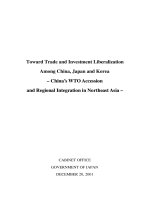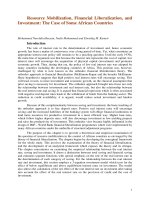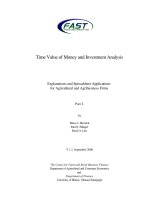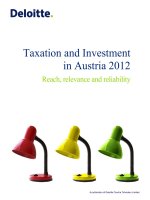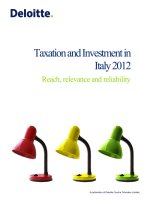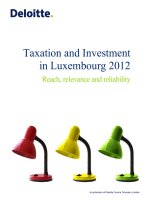Valuing companies and investment projects
Bạn đang xem bản rút gọn của tài liệu. Xem và tải ngay bản đầy đủ của tài liệu tại đây (648.55 KB, 53 trang )
This version 11/9/2001.
Includes WORD tables
Lecture:
Valuing Companies and
Investment Projects
Copyright K. Cuthbertson and D. Nitzsche
1
TOPICS
Basic Ideas
Compounding/Terminal Value
Discounted Present Value DPV \ Discounted Cash Flow DCF
Investment ( Project) Appraisal, Internal Rate Of Return,
Valuation Of The Firm: Enterprise Vale and Equity
~ choice of discount rate
~ valuation in practice: EBITD, Depreciation, FCF etc.
Complementary Valuation Techniques: EP, EVA,APV
Self Study: Other Investment Appraisal Methods
Copyright K. Cuthbertson and D. Nitzsche
2
READING
Investments:Spot and Derivative Markets, K.Cuthbertson
and D.Nitzsche
Chapter 3
Discounted Present Value DPV \ Discounted Cash Flow DCF
Internal Rate Of Return, IRR
Investment ( Project) Appraisal
Valuation Of The Firm And The Firm’s Equity (Incl. Continuing Value).
Valuation In Practice: EBITD, Depreciaiton, FCF etc
Other Investment Appraisal Methods
Chapter 11
Economic Profit, Economic Value Added, Adjusted Present Value
P. 342-346.
Copyright K. Cuthbertson and D. Nitzsche
3
BASIC IDEAS
Compounding/Terminal Value
Discounted Present Value DPV
Discounted Cash Flow DCF
Internal Rate of Return
Investment/ Project Appraisal
Copyright K. Cuthbertson and D. Nitzsche
4
Compounding/ Terminal Value
Assume zero inflation+cash flows known with certainty
Vo = value today ($1000), r = interest rate (0.10)
Value in 1,2 years time
V1 = (1.1) 1000 = $1100
V2 = (1.1) 1100 = (1.1) 2 1000 = $1210
Terminal Value after n-years:
Vn = Ao (1 + r)n
We could ‘move all payments forward’ to time n=10 years and
then add them - but we do not do this
Copyright K. Cuthbertson and D. Nitzsche
5
Discounting
‘Bring all payments back’ to t=0 and then add.
Value today of V2 = $1210 payable in 2 yrs ?
DPV =
V2
1210
=
(1 + r ) 2 (11
. )2
Hence “ DPV of $1210 is $1000”
Which means that $1000 today is equivalent to $ 1210
payable in 2-years
“Discount Factor” d2 =
1
(1+ r )2
Copyright K. Cuthbertson and D. Nitzsche
6
Discounted Present Value (DPV)
What is value today of stream of payments - usually
called ‘Cash Flows’, assuming a constant discount
factor? :
DPV =
V1
V2
+
+...
2
(1 + r ) (1 + r )
= d1 V1 + d2 V2 + ..
r = ‘discount rate’
d = “discount factor” < 1
Discounting, puts all future cash flows on to a ‘common
time’ at t=0 - so they can then be “added up”.
Copyright K. Cuthbertson and D. Nitzsche
7
Investment (Project) Appraisal:Decision Criteria
Operating Cash Flows, (ie. revenues less operating costs, less
taxes) V1 = $1100,
and
V2 = $1210
Then
DPV(of ‘cash flows’ at r =10%) = $2000
Suppose Capital Cost (Investment Expenditure), KC = $2000
Net Present Value (NPV):
NPV = DPV - KC
RULE: If DPV > KC then invest in project
OR
If NPV > 0
then invest in project
Our project is just ‘on the margin’ since NPV = 0 when r=10%
Copyright K. Cuthbertson and D. Nitzsche
8
NPV (for given CFs) and the cost of borrowing, r
NPV
If r <10% then you would invest in the
project
NPV=14
5
If r > 10% you would NOT invest in the
project
NPV=0
r=5
r=10
Copyright K. Cuthbertson and D. Nitzsche
r= loan rate
or discount
rate
9
Internal Rate Of Return (IRR)
Businessmen think in terms the rate of return on the
project
What is the rate of return (on capital investment of
$2000) ? 1100 + 1210 − 2000 = 0
(1 + IRR)
(1 + IRR) 2
It is the rate of return which gives NPV = 0
Hence the IRR is the ‘break-even’ discount rate and IRR = 0.10
(10%)
IRR INVESTMENT DECISION RULE
Copyright K. Cuthbertson and D. Nitzsche
10
Intuitively what do NPV and IRR rules mean ?
If
NPV = 0
OR, IRR = cost of borrowing then this
implies
-the CF from the project will just pay of
all the annual interest payments on the loan
+
the principal amount borrowed
from the bank
Note: Internal funds are not ‘free’
Copyright K. Cuthbertson and D. Nitzsche
11
Intuitively what do NPV and IRR rules mean ?
Payoff all interest and principal if
NPV=0 or IRR = 10% ?
KC=2000 (borrowed at r=10%), CF are
1
Year 2
V1=1100 , Year
V2=1210
Loan
2200 =
Outstanding
2000(1.1)
Net
Receipts
1100
Amount
Owed
1100
1210 =
1100 ( 1.1 )
Copyright K. Cuthbertson and D. Nitzsche
1210
0
12
Valuation of the Firm:
Enterprise Value and Equity Value
Copyright K. Cuthbertson and D. Nitzsche
13
Two Useful Math Results
General Case
V0 = FCF1 / (1+r) + FCF2 / ((1+r)2 + ……
FCF= Free Cash Flows
1) Sum to infinity and FCF is constant:
V0 = FCF / r
2) Sum to infinity and FCF grows at rate of g % p.a.
(g=0.05 )
V0 = FCF1 / ( r - g)
Copyright K. Cuthbertson and D. Nitzsche
14
‘Enterprise Value’ and ‘Equity Value’
Enterprise DCF
In practice investment costs occur every year so:
V(whole firm) = DPV ( Free Cash Flows, FCF)
FCF = (Operating ‘cash flows’ - Gross investment) each year
Value of Equity
V(Equity) = V(whole firm) - V(Debt outstanding)
‘Fair value for one share’ = V(Equity) / N
N = no. of shares outstanding (+ ‘minority interests’)
Copyright K. Cuthbertson and D. Nitzsche
15
‘Enterprise Value’ and Equity Value
In an efficient market the price of the
share(s) should equal ‘fair value’
We will learn how to value corporate
debt, in later lectures
Copyright K. Cuthbertson and D. Nitzsche
16
‘Valuing the ‘Firm’ :Continuing Value
The DPV of ALL the firm’s future cash flows is
often ‘split’ into two (or more) planning horizons:
‘ENTERPRISE DCF’
= DPV of FCF in years 1-5
+ DPV of ‘Continuing Value’ after year-5
Copyright K. Cuthbertson and D. Nitzsche
17
‘Valuing the ‘Firm’ :Continuing Value
Special Case A:
i) the discount rate is constant in each year
ii) Cash flows, FCF are constant in each year and persist
‘for ever’ (ie. perpetuity) then
CV =
FCF/ r
This is often used to calculate ‘continuing value’, CV.
Copyright K. Cuthbertson and D. Nitzsche
18
‘Valuing the ‘Firm’ :Continuing Value
eg. Project has
V5 =100 in year-5,6,7 etc., and r=0.10 then
Continuing value CV (at t=5) = 100 / 0.10 = 1,000
and
DPV (at t=0) of the CV
= 1000/ (1+r)5
Copyright K. Cuthbertson and D. Nitzsche
=
621
19
‘Valuing the ‘Firm’ :Continuing Value
Special Case B:
If
i) the discount rate is constant in each year
and
ii)FCF’s grow at a constant rate each year, say
after year-5 then
CV (at t=5) = FCF5 (1+g) / ( r - g)
Copyright K. Cuthbertson and D. Nitzsche
for r>g
20
‘Valuing the ‘Firm’ :Continuing Value
Project has FCF=100 in year-5
FCF grows at rate g=0.03 (3%) and r = 0.10
Then:
Continuing value CV (at t=5)
=
DPV( at t=0) of the CV
100 (1.03) / (0.10 - 0.03)= 1471
= 1471/ (1+r)5 =
913
Notes:
CV is very sensitive to the choices made for FCF5, R and g.
CV can be a large & dominates DPV of the cash flows over years 1-5.
Copyright K. Cuthbertson and D. Nitzsche
21
Company Valuation: M&A
Suppose
Value of firm using DPV of FCF’s is
Enterprise DCF = DPV (FCF 1-5yrs) + DPV (of CV)
=
679
+
621 =
1,300
Suppose: All equity financed firm N = 1000 shares and P= $1
Market Value (Capitalisation) =
$1000
Hence the shares are undervalued by 30%
Possible purchase or takeover target (by ‘arbs’)
Copyright K. Cuthbertson and D. Nitzsche
22
Shareholder Value (All equity financed firm)
If NPV of the project > 0 (discounted using R S)
Implies the managers are ‘adding value’ for shareholders
(which exceeds the return they could earn from investing
their money in other hamburger firms).
This is value based management or ‘creating shareholder
value’.
Copyright K. Cuthbertson and D. Nitzsche
23
Choice of Discount Rate
Copyright K. Cuthbertson and D. Nitzsche
24
Discount Rate: All equity financed firm
Note: ‘All equity’ financed = ‘unlevered firm’ - ie. no debt
Discount rate should reflect ‘business risk’ of the project.
Assume project is ‘scale enhancing’ (eg. more hamburger outlets
for McDonalds)
Hence, has same ‘business risk’ as the firm as a whole.
Simple method
Use the average (historic) return on equity, RS (e.g. 15%) for this
(hamburger) firm as the discount rate
This assumes the observed return on equity correctly reflects
the payment for risk, that shareholders require from this
hamburger company.
Copyright K. Cuthbertson and D. Nitzsche
25
